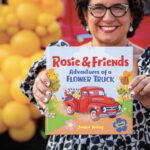 Spring is edging up quick now (oh, thank goodness!)–time to harness all that energy that flows into the gardener and the green thumbs. First up: Getting a game plan in place before you’re carried away by the cherry blossoms, which will help you organize the layers of abundance.
Spring is edging up quick now (oh, thank goodness!)–time to harness all that energy that flows into the gardener and the green thumbs. First up: Getting a game plan in place before you’re carried away by the cherry blossoms, which will help you organize the layers of abundance.
Checking out your tools right now is a great way to start getting your hands a little dirty. Using a wire brush, give your tools a nice scrubbing to remove clumps of dirt and surface rust. Spades and shovels work better with a nice, sharp edge, accomplished with a metal file. Rub oil on to them when you are done to keep the rust at bay. Drop your lawn mower blades off for sharpening for nice, clean cuts on the grass. Cleaned and sharpened pruners will be well appreciated as the cutting and trimming begins.
Decide what seeds you are going to start in March for planting outside or direct sowing. As soon as we receive one 70-degree day, plant lettuce, spinach, beets, carrots, peas and radish seeds directly into the soil. These types of seedlings love chilly weather! Wait until late March to start pumpkins and squash inside.
As we get set free from our cabin fever, the need to clean and tidy outside can be both an ambitious and obsessive activity. Start with raking all the leaves that blew underneath the shrubbery as winter set in. Consider putting in a pile and chopping up with the mower. Rake up the results, spreading this goodness in the vegetable garden (don’t do this with walnut leaves).
Don’t be too quick to prune. Many a flower bud is removed in this fertile period of doing. In particular, hydrangeas display stems that appear to be dead, yet the summer flower buds are held tightly at the tips of the very alive branches. On the other gloved hand, some shrubbery responds very well to a vigorous spring hack. Knockout roses, for instance, respond well to being cut down to 12 inches tall each spring. Call your local garden professionals and get the proper info—before you cut!
Fertilizing can be easily done using Espoma granular products. Since most of the perennials still are sleeping, and annuals haven’t been planted, the coast is clear for application. Use five pounds for every 100 square feet, scattering HollyTone around the trees and evergreen shrubs, FlowerTone for perennial and annual beds and GardenTone in the vegetable and herb areas. It’s always a good idea to get a soil test done every few years to see what nutrients might need a boost.
If you are expanding a bed or making a new island, landscaper marking paint is handy to get the lines just right. Be sure to notice how the lawn mower will maneuver. Perhaps an existing bed is challenging to mow around and could use a new curve or extension. When designing these new areas, notice if the area is sunny or shady, wet or dry for best success rate when choosing the plants.
Hopefully, you will plant at least one tree this year. Make it a good one! When choosing a tree, start by focusing in on the area where it will go. What are the soil conditions? Hot and dry or shady and moist? What size should it mature at? Often, the ultimate size of a tree is ignored, and perfectly good trees get cut down because they “got too big.” Trees never get too big. Instead, their potential growth is ignored. Look up and see if there are power lines. How close to the house will it be planted? Furthermore, be sure to choose a quality tree. All trees are not created equal! Ornamental pears, for example, are terrible trees. They are seeding into our native areas and often spilt in half from wind or heavy snow as they get older. Plus, the flowers smell awful! There are so many other wonderful trees to choose from—keep the diversity in our area expanding.
I always wrap up with a lawn awareness plea. Please stop using so many chemicals on your lawn. Dandelions are loved by many pollinators. Dandelion greens are an excellent detox for your system. Dandelion roots are full of health nutrients, as well as being your friend by busting that stout taproot through our heavy clay soils. Why on earth do Americans hate dandelions?? (The answer is we have been manipulated to do so through years of commercials and slick glossy ads!) I challenge you to let your dandelions grow and make wishes with the delightful seed heads.
Happy spring and good growing!
Erica Shaffer is the nursery manager at Highland Gardens, 423 S. 18th St., Camp Hill. www.highlandgardens.org.





